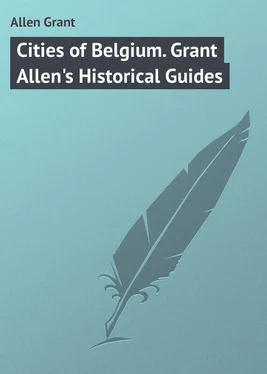Grant Allen - Cities of Belgium. Grant Allen's Historical Guides
Здесь есть возможность читать онлайн «Grant Allen - Cities of Belgium. Grant Allen's Historical Guides» — ознакомительный отрывок электронной книги совершенно бесплатно, а после прочтения отрывка купить полную версию. В некоторых случаях можно слушать аудио, скачать через торрент в формате fb2 и присутствует краткое содержание. ISBN: , Издательство: Иностранный паблик, Жанр: foreign_language, foreign_prose, на английском языке. Описание произведения, (предисловие) а так же отзывы посетителей доступны на портале библиотеки ЛибКат.
- Название:Cities of Belgium. Grant Allen's Historical Guides
- Автор:
- Издательство:Иностранный паблик
- Жанр:
- Год:неизвестен
- ISBN:http://www.gutenberg.org/ebooks/49690
- Рейтинг книги:3 / 5. Голосов: 1
-
Избранное:Добавить в избранное
- Отзывы:
-
Ваша оценка:
- 60
- 1
- 2
- 3
- 4
- 5
Cities of Belgium. Grant Allen's Historical Guides: краткое содержание, описание и аннотация
Предлагаем к чтению аннотацию, описание, краткое содержание или предисловие (зависит от того, что написал сам автор книги «Cities of Belgium. Grant Allen's Historical Guides»). Если вы не нашли необходимую информацию о книге — напишите в комментариях, мы постараемся отыскать её.
Cities of Belgium. Grant Allen's Historical Guides — читать онлайн ознакомительный отрывок
Ниже представлен текст книги, разбитый по страницам. Система сохранения места последней прочитанной страницы, позволяет с удобством читать онлайн бесплатно книгу «Cities of Belgium. Grant Allen's Historical Guides», без необходимости каждый раз заново искать на чём Вы остановились. Поставьте закладку, и сможете в любой момент перейти на страницу, на которой закончили чтение.
Интервал:
Закладка:
Most of the bones of St. Ursula and her 11,000 virgins are preserved at Cologne, the city of her martyrdom, where they are ranged in cases round the walls of a church dedicated in her honour; but her arm is here, and a few other relics are distributed elsewhere.
The Hospital is open daily from 9 to 6; Sundays, 3 to 6. 1 franc per person. If you have Conway, take it with you.]
From the Grand’ Place, turn down the Rue des Pierres, the principal shopping street of Bruges, with several fine old façades , many of them dated. At the Place Simon Stévin turn to the L., and go straight on as far as the church of Notre-Dame. The long brick building with Gothic arches, on your right, is the **Hospital of St. Johnthe Evangelist.
First, examine the brick Gothic exterior. Over the outer doorway is the figure of a bishop with a flaming heart, the emblem of St. Augustine, this being an Augustinian hospital. Continue on to the original main portal (now bricked up) with a broken pillar, and two 13th century reliefs in the tympanum. That to the right represents the Death of the Virgin, with the Apostles grouped around, and the figure of the Christ receiving her naked new-born soul as usual. Above is the Coronation of Our Lady. That to the left seems like a reversed and altered replica of the same subject, with perhaps the Last Judgment above it. It is, however, so much dilapidated that identification is difficult. (Perhaps the top is a Glory of St. Ursula.) Go on as far as the little bridge over the canal, to inspect the picturesque river front of the Hospital.
Return to the main portal and ring the inner bell. Admission, see above. The picturesare collected in the former Chapter-house of the Hospital, above the door of which is another figure of St. Augustine.
The centre of the room is occupied by the famous châsse or **shrinecontaining the arm of St. Ursula, a dainty little Gothic chapel in miniature. It is painted with exquisite scenes from the legend, by Memling, with all the charm of a fairy tale. He treats it as a poetical romance. Begin the story on the side towards the window. (For a penetrating criticism of these works, see Conway.)
1st panel , on the left: St. Ursula and her maidens, in the rich dress of the Burgundian court of the 15th century, arrive at Cologne, the buildings of which are seen in the background, correctly represented, but not in their true relations. In a window in the background to the R., the angel appears to St. Ursula in a vision.
2nd panel : the Virgins arrive at Basle and disembark from the ships. In the background, they are seen preparing to make their way, one by one, across the Alps, which rise from low hills at the base to snowy mountains. From another ship Conon and his knights are disembarking.
** 3rd panel : (the most beautiful:) the Maidens arrive at Rome. In the distance they are seen entering the city through a triumphal arch; in the foreground, St. Ursula kneels before St. Cyriacus and his bishops, with their attendant deacons, all the faces having the character of portraits. (Note especially the fat and jolly ecclesiastic just under the arch.) At the same time, her betrothed, Conon, with his knights, arrives at Rome by a different road, and is seen kneeling in a red robe trimmed with rich fur beside St. Ursula. (Fine portrait faces of Conon and an old courtier behind him.) The Pope and his priests are gathered under the portals of a beautiful round-arched building, whose exquisite architecture should be closely examined. To the extreme R., the new converts and Conon receive baptism naked in fonts after the early fashion. In the background of this scene, St. Ursula receives the Sacrament. (She may be recognised throughout by her peculiar blue-and-white dress, with its open sleeves.) To the left of her, Conon makes confession. In this, as in the other scenes, several successive moments of the same episode are contemporaneously represented. Look long at it.
Now, turn roundthe shrine, which swings freely on a pivot, to see the scenes of the return journey.
1st panel : (beginning again at the left:) the Pope and his bishops and cardinals embark with St. Ursula in the boat at Basle on their way to Cologne. Three episodes are here conjoined: the Pope cautiously stepping into a ship; the Pope seated; the ship sailing down the Rhine. All the faces here, and especially the timid old Pope stepping into the boat, deserve careful examination. In the background, the return over the Alps.
*2nd panel : the Maidens and the Pope arrive at Cologne, where they are instantly set upon by the armed Huns. Conon is slain by the thrust of a sword, and falls back dying in the arms of St. Ursula. Many of the maidens are also slaughtered.
*3rd panel : continuous with the last, but representing a subsequent moment: the Martyrdom of St. Ursula. The King of the Huns, in full armour, at the door of his tent, bends his bow to shoot the blessed martyr, who has refused his advances. Around are grouped his knights in admirably painted armour. (Note the reflections.) All the scenes have the character of a mediæval romance. For their open-air tone and make-believe martyrdom, see Conway.
At the endsof the shrine are two other pictures, (1) *St. Ursula with her arrow, as the protectress of young girls, sheltering a number of them under her cloak (not, as is commonly said, the 11,000 Virgins). Similar protecting figures of the saint are common elsewhere (Cluny, Bologna, etc.). At the opposite end, (2) the Madonna and Child with an apple, and at her feet two Augustinian nuns of this Hospital, kneeling, to represent the devotion of the order.
The roofof the shrine is also decorated with pictures. (1) St. Ursula receiving the crown of martyrdom from God the Father, with the Son and the Holy Ghost; at the sides, two angels playing the mandoline and the regal or portable organ; (2) St. Ursula in Paradise, bearing her arrow, and surrounded by her maidens, who shared her martyrdom, together with the Pope and other ecclesiastics in the background. (This picture is largely borrowed from the famous one by Stephan Lochner on the High Altar of Cologne Cathedral, known as the Dombild . If you are going on to Cologne, buy a photograph of this now, to compare with Meister Stephan later. His altar-piece is engraved in Conway. If you have it with you, compare them.) At the sides are two angels playing the zither and the violin. (The angels are possibly by a pupil.)
I have given a brief description only of these pictures, but every one of them ought to be carefully examined, and the character of the figures and of the landscape or architectural background noted. You will see nothing lovelier in all Flanders.
Near the window by the entrance is a **Triptych, also by Memling, commissioned by Brother Jan Floreins of this Hospital. The central panel represents the Adoration of the Magi, which takes place, as usual, under a ruined temple fitted up as a manger. The Eldest of the Three Kings (according to precedent) is kneeling and has presented his gift; Joseph, recognisable (in all three panels) by his red-and-black robe, stands erect behind him, with the presented gift in his hands. The Middle-aged King, arrayed in cloth of gold, with a white tippet, kneels with his gift to the L. of the picture. The Young King, a black man, as always, is entering with his gift to the right. The three thus typify the Three Ages of Man, and also the three known continents, Europe, Asia, Africa. On the L. side of this central panel are figured the donor, Jan Floreins, and his brother Jacob. (Members of the same family are grouped in the well-known “Duchâtel Madonna,” also by Memling, in the Louvre.) To the right is a figure looking in at a window and wearing the yellow cap still used by convalescents of the Hospital, (arbitrarily said to be a portrait of Memling.) The left panel represents the Nativity, with our Lady, St. Joseph, and two adoring angels. The right panel shows the Presentation in the Temple, with Simeon and Anna, and St. Joseph (in red and black) in the background. (The whole thus typifies the Epiphany of Christ; left, to the Blessed Virgin; centre, to the Gentiles; right, to the Jews.) The outer panels , in pursuance of the same idea, have figures, right, of St. John Baptist with the lamb (he pointed out Christ to the Jews), with the Baptism of Christ in the background; and left, St. Veronica, who preserved for us the features of our Lord, displaying his divine face on her napkin. The architectural frame shows the First Sin and the Expulsion from Paradise. Note everywhere the strong character in the men’s faces, and the exquisite landscape or architectural backgrounds. Dated 1479. This is Memling’s finest altar-piece: its glow of colour is glorious.
Читать дальшеИнтервал:
Закладка:
Похожие книги на «Cities of Belgium. Grant Allen's Historical Guides»
Представляем Вашему вниманию похожие книги на «Cities of Belgium. Grant Allen's Historical Guides» списком для выбора. Мы отобрали схожую по названию и смыслу литературу в надежде предоставить читателям больше вариантов отыскать новые, интересные, ещё непрочитанные произведения.
Обсуждение, отзывы о книге «Cities of Belgium. Grant Allen's Historical Guides» и просто собственные мнения читателей. Оставьте ваши комментарии, напишите, что Вы думаете о произведении, его смысле или главных героях. Укажите что конкретно понравилось, а что нет, и почему Вы так считаете.












